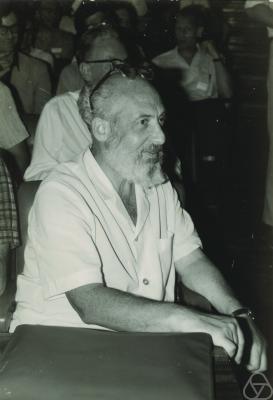Samuel Eilenberg facts for kids
Quick facts for kids
Samuel Eilenberg
|
|
|---|---|

Samuel Eilenberg (1970)
|
|
| Born | September 30, 1913 Warsaw, Congress Poland, Russian Empire
|
| Died | January 30, 1998 (aged 84) New York City, United States
|
| Citizenship | Russian, Polish, American |
| Alma mater | University of Warsaw |
| Known for | Acyclic model Category theory X-machine Weak dimension Projective module Shuffle algebra Simplicial set Standard complex Eilenberg's obstruction theory Eilenberg swindle Eilenberg–Ganea conjecture Eilenberg–Ganea theorem Eilenberg–MacLane space Eilenberg–Moore spectral sequence Eilenberg–Niven theorem Eilenberg–Steenrod axioms Eilenberg–Zilber theorem Cartan–Eilenberg resolution Chevalley–Eilenberg complex |
| Awards | Wolf Prize (1986) Leroy P. Steele Prize (1987) |
| Scientific career | |
| Fields | Mathematics |
| Institutions | Columbia University |
| Thesis | On the Topological Applications of Maps onto a Circle (1936) |
| Doctoral advisors | Kazimierz Kuratowski Karol Borsuk |
| Doctoral students | Jonathan Beck David Buchsbaum Martin Golumbic Daniel Kan William Lawvere Ramaiyengar Sridharan Myles Tierney |
Samuel Eilenberg (born September 30, 1913 – died January 30, 1998) was a famous Polish-American mathematician. He is best known for helping to create two important areas of mathematics: category theory (with Saunders Mac Lane) and homological algebra.
Contents
Early Life and Education
Samuel Eilenberg was born in Warsaw, which was then part of the Russian Empire, into a Jewish family. He grew up and studied there, showing a great talent for mathematics.
He earned his Ph.D. (a very high university degree) from the University of Warsaw in 1936. His main project for this degree was called On the Topological Applications of Maps onto a Circle. His teachers, Kazimierz Kuratowski and Karol Borsuk, helped him a lot with his studies.
Later in his life, he moved to the United States and spent most of his career as a professor at Columbia University in New York City. He passed away in New York City in January 1998.
Contributions to Mathematics
Eilenberg's most important work was in a field called algebraic topology. This area of math uses tools from algebra to study shapes and spaces.
Creating New Math Fields
He worked with another mathematician, Norman Steenrod, on how to define homology theory using a set of rules called axioms. These rules are now known as the Eilenberg–Steenrod axioms.
Even more famously, Eilenberg teamed up with Saunders Mac Lane. Together, they developed homological algebra and, in the process, created a brand new field of math called category theory. Category theory is a way to study mathematical structures and the relationships between them in a very general way.
Working with Bourbaki
Eilenberg was also a member of a group of French mathematicians who wrote under the name Nicolas Bourbaki. With Henri Cartan, he wrote an important book in 1956 called Homological Algebra.
Later in his career, he focused mostly on pure category theory, helping to build it into the important field it is today. He also came up with a clever math trick called the Eilenberg swindle, which helps simplify problems with certain types of mathematical objects called projective modules.
Computers and Automata
Beyond pure math, Eilenberg also contributed to automata theory. This field deals with abstract machines and how they process information, which is important for understanding computers. He introduced a model of computation called the X-machine.
Art Collection
Samuel Eilenberg was not only a brilliant mathematician but also a passionate collector of Asian art. His collection included many small sculptures and other beautiful items from countries like India, Indonesia, Nepal, Thailand, Cambodia, Sri Lanka, and Central Asia.
In the early 1990s, the famous Metropolitan Museum of Art in New York City held a special exhibition. It featured more than 400 pieces that Eilenberg had given to the museum. The exhibition was called The Lotus Transcendent: Indian and Southeast Asian Art From the Samuel Eilenberg Collection. In return for his generous donations, the museum helped fund a special professorship in mathematics at Columbia University, named after Samuel Eilenberg.
Images for kids
-
Saunders Mac Lane and Eilenberg at a conference in July 1992
See also
 In Spanish: Samuel Eilenberg para niños
In Spanish: Samuel Eilenberg para niños
- Stefan Banach
- Stanislaw Ulam
- Eilenberg–Montgomery fixed point theorem


